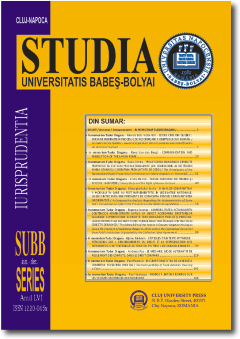DREPTUL LA APEL CĂTRE SFÂNTUL SCAUN, AL INSTITUȚIILOR ECLEZIASTICE DIN TRANSILVANIA, ÎN SECOLUL AL XIII-LEA
THE RIGHT TO APPEAL TO HOLLY SEE IN XIII CENTURY.
THE CASE OF ECLESSIASTICAL INSTITUTIONS IN TRANSYLVANIA
Author(s): Tudor ȘtefănescuSubject(s): Law, Constitution, Jurisprudence
Published by: Studia Universitatis Babes-Bolyai
Keywords: right to appeal under Canon Law; eclesiastical institutions; Canon Law; Middle Ages; Medieval Transylvania; Holly See.
Summary/Abstract: The aim of this article is to underline the development and the use of the right of appeal to the Pontifical Court, in the kingdom of Hungary, especially in the east region of Transylvania in the XIII century.The right of appeal as a branch of roman law, was studied and put in practice in a rigorous way, for the first time in the XII century, in Italian space, as a part of the medieval cultural phenomenon called The Renaissance of Roman Law. The right of appeal has been introduced in the canon law, therefore the clerics, who were discontent with the sentences issued in local trials, have received the right to appeal to the supreme judgement of the Holly See.In the XIII century, in the epoch of hierocracy, the canon law, including the right of appeal became universal law. Particularly, pope Innocent III, in 1198 offers for the first time the right of appeal to bishop of Transylvania. Therefore, during XIII century, the bishops together with other eclesiastical institutions of Transylvania as chapters and abbeys use the right of appeal to Holly See. As a consequence, the Apostolic See interferes more than 40 times in the internal affairs of eclesiastical institutions and that means a strong connection between Transylvania, the eastern part of Societas Christiana and Rome.
Journal: Studia Universitatis Babes Bolyai - Iurisprudentia
- Issue Year: 63/2018
- Issue No: 1
- Page Range: 61-94
- Page Count: 34
- Language: Romanian

